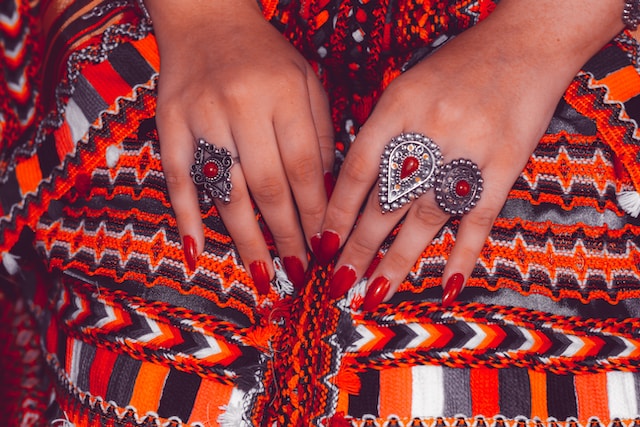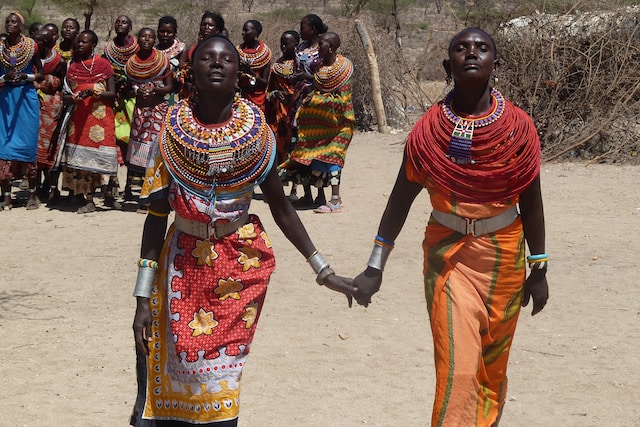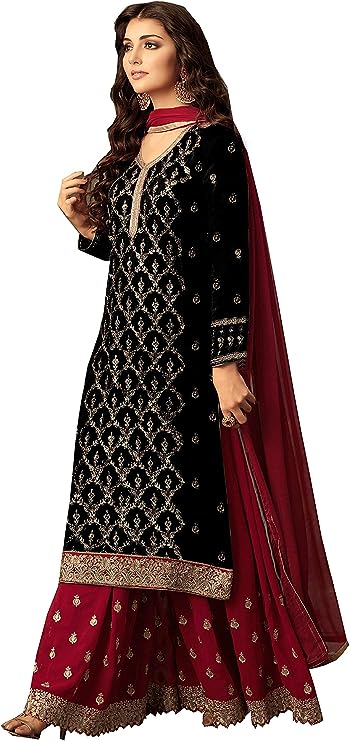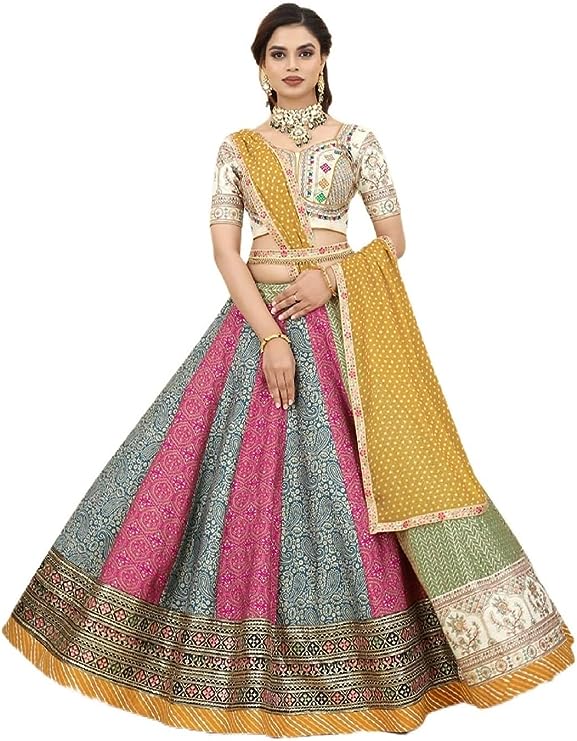
What Traditional Dress?
Traditional dress refers to the attire worn by women that reflects the cultural and historical heritage of a particular region or country.
These dresses are typically associated with special occasions, festivals, and important ceremonial events. They are a representation of the country’s traditional values and customs, often featuring intricate designs, vibrant colors, and detailed craftsmanship.
Traditional dress for women varies greatly across different cultures and regions, showcasing the diversity and unique identities of each community.
From the elegant sarees and lehenga cholis of India to the kimono of Japan and the hanbok of Korea, traditional dresses play a significant role in preserving and celebrating cultural heritage. With their rich history and timeless beauty, traditional dresses hold a special place in women’s fashion, symbolizing the pride, tradition, and identity of a community or nation.

History of Traditional Dress for Women
The history of traditional dress for women in India is rich and diverse, with origins dating back thousands of years. Traditional Indian attire has evolved over time, influenced by the various cultures, regions, and historical events that have shaped the nation.
The significance of traditional dress goes beyond mere fashion. It is a reflection of India’s cultural heritage and serves as a symbol of identity, particularly during special occasions and festivals. From the vibrant sarees of South India to the intricate lehenga cholis of North India, each region has its style and design.
The evolution of traditional dress can be traced back the Indus Valley civilization, where evidence of draped clothing has been found. Over the centuries, the arrival of various cultures and conquerors, including the Mughals and British, left their mark on Indian fashion, leading to the fusion of different styles and designs.

Today, traditional Indian attire continues to be celebrated and loved not only within the country but also around the world. Indian designers have blended traditional and modern designs, creating a wide range of options for women to choose from.
In summary, the history of traditional dress for women in India showcases the rich cultural heritage and diverse influences that have shaped it over time. It remains an integral part of Indian identity and is cherished during festivals, special occasions, and everyday wear.
Types of Traditional Dress for Women
Indian traditional dress for women encompasses a wide range of styles, reflecting the diversity and rich cultural heritage of the country. From sarees and lehengas to salwar kameez and anarkali suits, each type of traditional attire has its own distinct characteristics and significance. Sarees, considered one of the oldest forms of clothing in India, are long pieces of fabric that are draped around the body in various styles. Lehengas are heavily embroidered long skirts worn with a choli and a dupatta, a long scarf. Salwar kameez, on the other hand, consists of loose-fitting pants, a tunic-style top, and a dupatta. Anarkali suits are typically worn for festive occasions and weddings. These traditional dresses not only showcase the beauty and craftsmanship of Indian textiles but also represent the cultural roots and traditions of the women who wear them. No matter the occasion, there is a traditional dress that perfectly captures the essence of Indian femininity and grace.
Sarees
Saree, a quintessential Indian garment, holds immense significance in traditional Indian attire for women. This elegant drape comes in various types, styles, and materials. Sarees are mostly worn during special occasions and festive seasons, as well as on a daily basis.
The different types of sarees include Banarasi, Kanjivaram, Chanderi, Tussar, and Georgette. Each type showcases unique craftsmanship and cultural essence. The Banarasi saree, known for its gold and silver zari work, is a symbol of opulence and grandeur. On the other hand, the intricate motifs and rich colors of a Kanjivaram saree reflect the vibrant culture of South India.

Sarees are crafted with a range of materials such as silk, cotton, chiffon, and satin. Silk sarees display a luxurious and regal appeal, while cotton sarees are comfortable and suitable for daily wear. Chiffon and satin sarees are popular for their lightweight nature and elegant drape.
These sarees not only reflect the diversity of Indian fashion but also embody the heritage and traditions of the country. They showcase the creativity of Indian fashion designers and the rich history of craftsmanship. Sarees have been an integral part of Indian culture for centuries and continue to be cherished as a symbol of femininity and tradition.
Lehengas Choli
Lehenga Choli is a traditional dress for women in India, particularly worn on special occasions and festive celebrations. This attire exudes elegance and grace, making it a popular choice for Indian women.
Lehengas Choli consists of three main components – a lehenga, a choli (blouse), and a dupatta (scarf). The lehenga is a pleated skirt that falls gracefully around the waist, while the choli is a fitted blouse that accentuates the woman’s upper body. The dupatta completes the outfit by adding a touch of elegance and can be draped in different styles.

Lehenga Choli is known for its vibrant colors, intricate embroidery, and beautiful embellishments. Traditional designs are often inspired by Indian culture and heritage, featuring motifs like paisleys, floral patterns, and geometric designs. Fashion designers in India continuously innovate and create modern designs, blending traditional and contemporary elements to cater to the evolving fashion sensibilities of Indian women.
The versatility of Lehenga Choli allows it to be worn for weddings, festivals, and parties. It can be styled differently, with options ranging from heavy, ornate pieces for bridal wear to lighter, more casual options for other events. This wide range of choices makes Lehenga Choli a must-have in every Indian woman’s wardrobe.
In conclusion, Lehenga Choli is a traditional dress that beautifully represents the cultural diversity and rich heritage of India. With its vibrant colors, intricate embroidery, and modern designs, it continues to be a popular choice among Indian women for special occasions and festivities.
Salwar Kameez
Salwar Kameez is a traditional garmet for women in India that consists of a loose-fitting tunic called the kameez and a pair of pants called the salwar. This versatile ensemble comes in a wide variety of styles, designs, and features that cater to the diverse fashion preferences of Indian women.
The history of Salwar Kameez dates back centuries and is deeply rooted in Indian culture. It has evolved over time, influenced by various regions and cultures within India. The dress holds immense cultural significance, representing the rich heritage and traditions of the country.

Salwar Kameez is known for its beautiful fabrics, patterns, and embellishments. Popular fabrics used include cotton, silk, georgette, and chiffon, offering comfort and breathability. Patterns vary from intricate embroidery and mirror work to block prints and hand-painted designs. Embellishments like sequins, beads, and zari work add a splash of elegance to the dress.
The beauty of Salwar Kameez lies in its function to be worn for both casual and formal events. It can be styled in different ways, such as pairing it with a dupatta or accessorizing with statement jewelry. The dress not only showcases Indian traditions but also reflects the individual style and personality of the wearer.
In conclusion, Salwar Kameez is a timeless and cherished traditional dress for women in India. Its styles, designs, and features have evolved over time, showcasing the vibrant cultural diversity of the country. With its wide range of fabrics, patterns, and embellishments, Salwar Kameez continues to be a symbol of elegance and grace for Indian women.
Anarkali Suits
Anarkali suits are a timeless and elegant form of traditional Indian dress that has gained immense popularity over the years. Named after the legendary courtesan Anarkali from the Mughal era, these suits exude grace and charm.
One of the standout features of an Anarkali suit is its flared silhouette. The long gown-like dress falls gracefully from the yoke and flares out at the bottom, creating a regal look. This design flatters all body types and adds a touch of poise and sophistication.
Anarkali suits come in various lengths, ranging from knee-length to floor-length. The floor-length Anarkali suits are particularly popular for formal events and special occasions, as they exude a majestic aura. They also often feature intricate embroidery, adding a touch of opulence to the outfit.

The sleeves of an Anarkali suit can vary, with options like full sleeves, three-fourth sleeves, or sleeveless. These variations allow for customization based on personal preferences and the occasion.
These suits are typically paired with a dupatta, which adds an extra element of grace and can be draped in different styles to complement the overall look.
Anarkali suits have cemented their place as a go-to option for formal events, festivals, and weddings. They have made a strong comeback in recent years, with fashion designers creating stunning variations in prints, colors, and embroidery styles. Anarkali suits continue to be a favorite choice for women who want to embrace the beauty of Indian traditional dress while making a style statement.
Palazzo Suits
Palazzo suits are a trendy and fashionable option for women looking to make a statement with their traditional attire. Originating from the fashion capital of India, Mumbai, palazzo suits have gained immense popularity for their comfortable yet stylish designs.
One of the defining features of palazzo suits is the wide-legged pants known as palazzo pants. These pants are loose-fitting and flowy, providing utmost comfort and ease of movement. They are usually paired with a kurta or top that can vary in length and style, allowing for versatility in designing a unique outfit.
Palazzo suits come in a variety of designs, from intricate embroidery and embellishments to vibrant prints and patterns. The combination of Indian ethnic aesthetics with modern designs has made palazzo suits suitable for both traditional and contemporary occasions.

The beauty of palazzo suits lies in their versatility, making them suitable for various events such as festivals, weddings, parties, and even casual outings. Whether it is a classic silk palazzo suit for a traditional wedding or a trendy printed palazzo suit for a festive celebration.
To complete the ensemble, palazzo suits are often paired with a dupatta. This ethereal piece can be draped in different styles to add grace and elegance to the overall look.
With their origins in Mumbai and a fusion of traditional and modern designs, palazzo suits have become a go-to choice for women seeking a unique and stylish traditional outfit. Embracing comfort and fashion, palazzo suits are an excellent addition to any wardrobe.
Ghagras/Chaniyas/Lahangas and Heavy Embroidered Suits
Ghagras, Chaniyas, and Lahangas are traditional dresses that hold a special place in Indian culture. These garments are known for their vibrant colors, intricate embroidery, and rich fabrics. Ghagras, also known as lehengas, are long skirts that are usually flared or pleated. Chaniyas are similar to Ghagras but have a more playful and festive vibe, often worn during traditional Gujarati celebrations like Navratri. Lahangas typically have a more modest and elegant design, often worn for weddings and special occasions.
One of the distinguishing features of these traditional dresses is the heavy embroidery work. Skilled artisans meticulously craft intricate designs using threads, beads, and stones. The embroidery patterns can range from delicate floral motifs to intricate geometric designs, adding to the beauty and uniqueness of each piece.

These traditional dresses are commonly worn during festive celebrations such as weddings, religious ceremonies, and cultural events. They are also favored attire for special occasions like Diwali, Eid, and Navratri. The stunning colors and luxurious fabrics of Ghagras, Chaniyas, and Lahangas make them a symbol of elegance and grace, reflecting the rich heritage and traditions of India.
In conclusion, Ghagras, Chaniyas, and Lahangas, with their heavy embroidery and exquisite designs, are traditional dresses that hold immense cultural and fashion significance in India. These beautiful garments are frequently worn during festive celebrations and special occasions, showcasing the vibrant colors and craftsmanship that are synonymous with Indian culture.
Different Styles of Wearing Traditional Dresses for Women in India
India boasts a rich cultural diversity, and the traditional dresses worn by women reflect this vibrant tapestry. There are various styles and ways of wearing traditional attire that differ across different regions of the country. In North India, women often opt for lehengas and anarkali suits, which are known for their elegance and intricate designs. In South India, sarees are the dominant choice, with their graceful drapes and elaborate borders. Additionally, there are various styles of draping the saree, each unique to a specific region. In other parts of the country, women wear different variations of salwar kameez or ghagra choli, each representing the cultural identity of their respective regions. The traditional dresses in India are not limited to these styles, as every state has its own distinct clothing heritage. Today, these traditional dresses are also being blended with modern designs to cater to the evolving fashion preferences and to provide a wide range of choices for women. Whether it’s a festive occasion or a special event, traditional dresses in India continue to be a symbol of grace and elegance, enabling women to showcase their rich cultural heritage.
North Indian Style
The North Indian style of traditional dress for women in India is known for its vibrant colors, intricate designs, and rich cultural significance. From sarees to lehengas choli, salwar kameez to anarkali suits, and palazzo suits, North Indian women have a wide range of traditional attire to choose from for various occasions.
Sarees are a timeless classic and epitomize grace and elegance. They are usually made of silk or chiffon and can be worn in many of ways, showcasing the versatility of this garment. Lehengas choli, on the other hand, consist of a flared skirt paired with a blouse and a scarf. They are commonly worn for weddings and festive occasions.
Salwar kameez is a popular choice for everyday wear. It is made up of a long tunic, called a kameez, paired with loose-fitting pants known as salwar, and a dupatta. Anarkali suits are similar to salwar kameez but have a flared silhouette and are often worn for special events.
Palazzo suits are another trendy option. They feature wide-legged pants paired with a short or long kurta, offering comfort and style.
These traditional dresses hold immense cultural significance, reflecting the traditions and heritage of North India. Often adorned with embroidery, sequins, and beads, adding to their beauty. Unlike other styles, North Indian attire is known for its vibrant colors and elaborate designs, showcasing the richness of Indian culture.
Whether it’s a wedding, festival, or any special occasion, North Indian women embrace their traditional dress with pride and elegance, making a bold fashion statement wherever they go.
South Indian Style
In South India, traditional dress for women is characterized by its distinct style and influence from the region’s rich history and culture. One of the prominent aspects of South Indian style is the use of silk and cotton fabrics. Silk, known for its lustrous texture and vibrant colors, is commonly used to craft traditional drapes like the Kanjeevaram saree.
Intricate designs play a significant role in South Indian attire. Elaborate motifs, geometric patterns, and temple borders are commonly seen on sarees and other traditional garments. The detailed hand embroidery and zari work adds a touch of opulence and intricacy to these outfits.

The South Indian traditional dress style also reflects the influence of the Mughal period on textile techniques. The use of gold and silver threadwork, known as zari, is reminiscent of the Mughal era, lending a regal touch to the attire.
Cotton fabrics, such as the traditional Kerala saree and Kasavu saree, are popular for their simplicity and comfort. The light and breathable cotton fabric make these sarees suitable for the region’s warm climate.
Overall, South Indian style of traditional dress for women is a beautiful blend of silk and cotton fabrics, intricate designs, and influences from the Mughal period. It showcases the rich cultural heritage and artistic craftsmanship of the region.
Western Indian Style
The Western Indian style of traditional dress is a beautiful fusion of Indian and Western fashion, seamlessly incorporating elements from both cultures. This unique blend creates a vibrant and contemporary look that is perfect for special occasions and festive celebrations.
One of the key characteristics of Western Indian style is the use of Indo-Western dresses. These outfits combine traditional Indian silhouettes with modern Western cuts and styles, resulting in a harmonious blend of elegance and comfort. Ethnic shrugs and jackets are also popular additions to Western Indian attire, adding an extra layer of style and flair.
Dhoti pants are another hallmark of Western Indian fashion. These comfortable and versatile bottoms can be paired with a variety of tops. They add a touch of tradition to the overall look while still maintaining a contemporary edge.
To complete the Western Indian style, dramatic makeup is often used to enhance the overall appearance. Vibrant colors, such as deep reds and rich golds, are commonly used on the eyes and lips to add a touch of glamour.
Overall, the Western Indian style offers a perfect balance between Indian traditions and modern designs, making it a popular choice for those who want to exude both elegance and fashion-forwardness.
Occasions to Wear a Traditional Dress for Women in India
In India, traditional dresses hold immense cultural and historical significance. They are not just garments, but embodiments of tradition and celebration. From weddings and festivals to religious ceremonies and special occasions, women in India don traditional dresses as a way to honor their heritage and showcase the splendor of their culture. These ethereal ensembles are a visual treat, crafted with exquisite embroidery, vibrant colors, and meticulous attention to detail. Whether it’s a grand saree, an ornate lehenga choli, or a gracefully draped salwar kameez, these traditional attires bring an unparalleled charm and elegance to any event. Let’s explore the occasions where women adorn themselves with these captivating pieces.

1. Festivals and Religious Ceremonies:
India is a land of festivals, and each region has its own set of unique celebrations. During auspicious occasions like Diwali, Navratri, Eid, or Christmas, women drape themselves in traditional dresses to pay homage to their religious customs and join in the festive spirit. Be it a resplendent saree, an opulent anarkali suit, or a stylishly embellished kurta with palazzo pants, women radiate grace and joy in these traditional outfits.
2. Weddings and Special Occasions:
Indian weddings are extravagant affairs, and women spare no effort in choosing the perfect traditional attire for these grand events. The bride herself adorns exquisite bridal wear, such as a dazzling red saree or a heavily embroidered lehenga, while guests dress in equally stunning ensembles. Special occasions like engagement ceremonies, anniversaries, and lavish parties also call for traditional dresses, allowing women to showcase their elegance through intricate designs, vibrant colors, and majestic drapes.
3. Cultural and Folk Events:
India’s rich cultural heritage is celebrated through diverse cultural and folk events across the country. From classical dance performances like Bharatanatyam and Kathak to traditional music concerts and art exhibitions, women often don traditional dresses to honor and express their love for their cultural roots. Traditional silk sarees like Banarasi and Kanjivaram, or region-specific attire like the Gujrati chaniya choli or Bengali saree, are popular choices during these events.
4. Formal and Corporate Gatherings:
In recent times, there has been a resurgence in the popularity of traditional dresses in the corporate world. Many offices have dedicated days or events where employees are encouraged to wear ethnic wear. Women opt for elegant sarees, contemporary salwar kameez, or fusion attire like Indo-Western dresses to add a touch of sophistication and cultural depth to formal gatherings. These outfits not only reflect their Indian identity but also project a confident and professional image.
Traditional dresses hold a significant place in the hearts of Indian women. They not only celebrate the rich heritage of the country but also allow women to embrace their cultural roots and express their individuality. Whether it’s for festive occasions, weddings, cultural events, or professional gatherings, traditional attire helps women embody the grace, beauty, and diversity of Indian culture, making them a timeless symbol of elegance and celebration.
Festive Occasions
Festive occasions in India are an integral part of the cultural fabric, where traditional dresses for women take center stage. These celebrations hold immense importance and represent the diversity and splendor of the country’s rich heritage. From religious festivals like Diwali, Eid, and Navratri to cultural events like weddings and regional festivities, traditional dresses play a pivotal role in honoring traditions and showcasing the elegance of Indian women.
During these festive occasions, women adorn themselves in traditional dresses that reflect the vibrancy and opulence of the festivities. Sarees, lehenga cholis, anarkali suits, and salwar kameez are common choices for these special events. Elaborate embroidery, rich colors, and intricate detailing elevate the allure of these attires, allowing women to exude grace and beauty.
Not only do these traditional dresses highlight the cultural significance of the celebrations, but they also create a sense of unity and belonging. They serve as a medium to express the shared values, customs, and traditions of the community. Festive occasions provide a platform for women to revel in the cultural extravaganza that India offers and immerse themselves in the joy and happiness that comes with it.
In essence, these celebratory moments are a testament to the cultural diversity and deep-rooted traditions of India. They give women the opportunity to showcase their inherent beauty, elegance, and pride through the mesmerizing array of traditional dresses woven into the fabric of the country’s festivities.